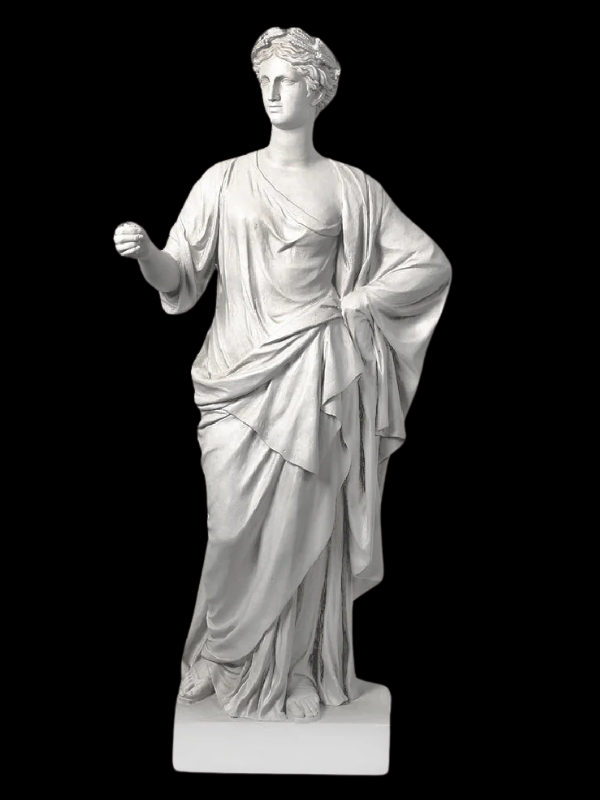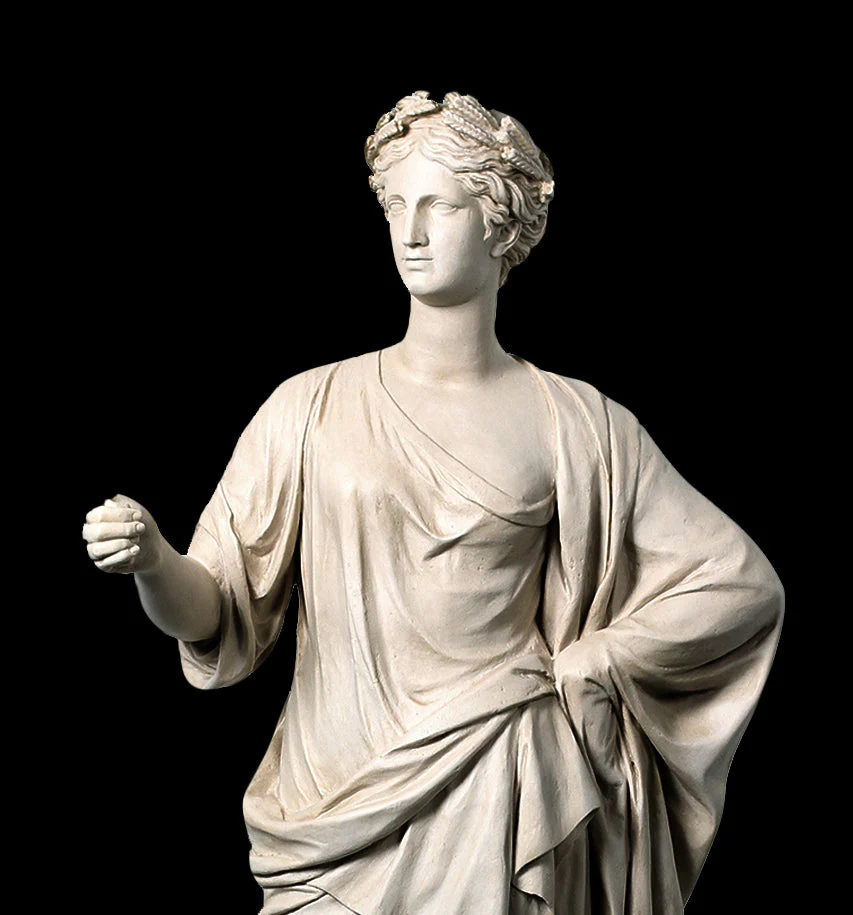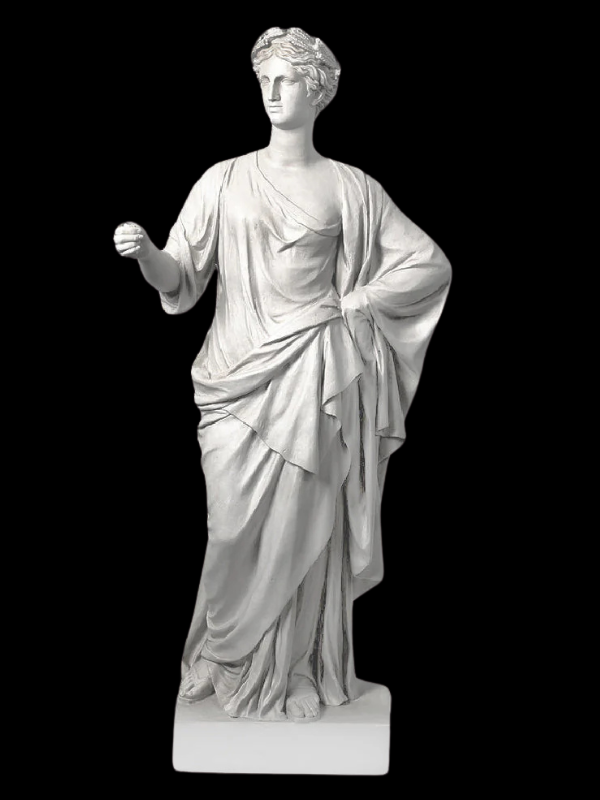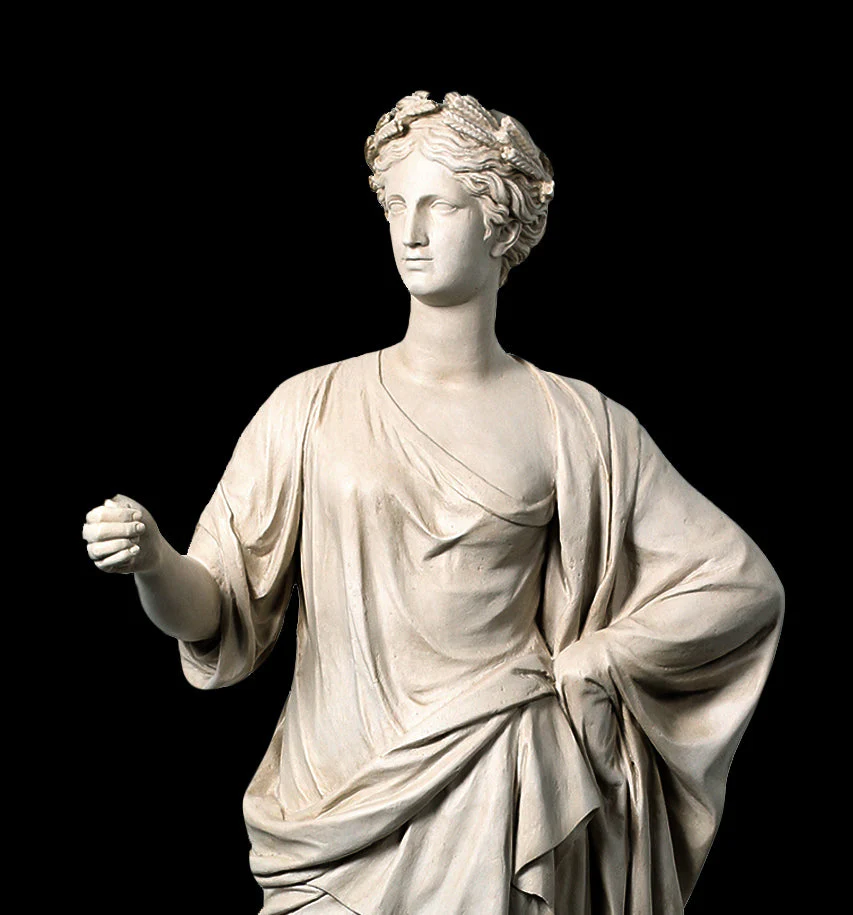Ceres Life Size Statue
Ceres Life Size Statue
Our Ceres Crowned with Wheat Wreath Life-size Statue (Large) is a stunning reproduction of a neoclassical masterpiece from a private collection dating to the 18th Century. This elegant statue represents Ceres, the ancient Roman goddess of agriculture, grain crops, fertility, and motherly relationships. Revered for her role in ensuring the abundance of the harvest and the fertility of the land, Ceres embodies the nurturing spirit of nature, a powerful symbol of life and sustenance.
This life-size sculpture stands at 183 cm (71.4 inches) in height, creating a striking presence that will captivate viewers in any setting. The goddess is portrayed with a wheat wreath crown, a symbol of her dominion over agriculture and the fertility of the earth. The delicate details of the wheat stalks are meticulously sculpted, paying homage to the role of Ceres as the bringer of nourishment and sustenance to humanity.
Crafted with natural white marble and architectural resin, this statue is both durable and elegant, making it suitable for display in a variety of environments. Whether it graces an interior space or an outdoor garden, this timeless figure brings with it a sense of classical beauty and reverence for the natural world.
Dimensions and Craftsmanship
The Ceres Life-size Statue is an exquisite example of neoclassical craftsmanship, designed to replicate the grace and grandeur of ancient Roman art while also reflecting the artistic sensibilities of the 18th century.
-
Height: The statue stands at 183 cm (71.4 inches), giving it an impressive life-size scale that allows the viewer to fully appreciate its intricate details. The statue’s stature reinforces the goddess’s role as a protector of the land and a provider of life-giving crops.
-
Width and Depth: With a width of 84 cm (32.8 inches) and a depth of 36 cm (14 inches), the statue is proportioned to convey both elegance and stability. The broad width of the figure suggests the expansive reach of Ceres’s influence, while the refined depth adds to the delicacy of the sculpture’s overall design.
-
Weight: Weighing 90 kg (198 lbs), the statue is substantial, providing a solid and enduring presence whether placed indoors or outdoors. The combination of natural white marble and architectural resin ensures that the statue is both robust and graceful, capable of withstanding the test of time.
-
Materials: The use of natural white marble gives the statue a timeless, classical appearance, while the architectural resin enhances its durability and resilience. This blend of materials ensures that the statue can be displayed in a variety of environments without losing its pristine beauty.
Symbolism of Ceres
In Roman mythology, Ceres was one of the most significant deities, revered for her role in agriculture and fertility. As the goddess of the harvest, she was intimately connected with the cycles of nature, ensuring the growth of crops and the fertility of the land. The statue’s detailed portrayal of Ceres with her wheat wreath underscores her association with grain and agricultural abundance, making this statue a powerful symbol of nature's bounty.
-
Wheat Wreath: The wheat wreath that crowns Ceres’s head is a prominent feature of the statue, symbolizing her control over the harvest and her ability to provide nourishment to humanity. The detailed rendering of the wheat stalks reflects the importance of agriculture in ancient Roman society and Ceres’s divine role in maintaining the fertility of the earth.
-
Motherly Relationships: Ceres was also revered as a goddess of motherhood and family. In myth, she was closely associated with her daughter Proserpina (Persephone in Greek mythology), and her story represents the bond between mother and child, as well as the natural cycle of life, death, and rebirth. The nurturing qualities of Ceres are embodied in this statue, which captures her grace and strength.
-
Fertility and Life: As the goddess of fertility, Ceres played a crucial role in ensuring the continuation of life. Her presence was invoked during planting and harvesting seasons, and festivals were held in her honor to ensure bountiful crops. This statue serves as a tribute to the essential role that fertility and agriculture played in the survival and prosperity of ancient civilizations.
Artistic Legacy and Neoclassical Influence
The Ceres Crowned with Wheat Wreath Life-size Statue reflects the artistic ideals of the neoclassical period, a time when artists sought to revive the classical traditions of ancient Greece and Rome. The neoclassical movement emphasized balance, proportion, and harmony, and this statue captures these qualities with its graceful pose, refined features, and meticulous attention to detail.
-
Neoclassical Aesthetics: The statue's design is rooted in neoclassical aesthetics, characterized by its symmetry, clarity of form, and idealized beauty. The graceful lines and elegant proportions of the statue reflect the neoclassical artists' admiration for the art of antiquity and their desire to emulate the perfection of classical sculpture.
-
Timeless Elegance: The statue’s depiction of Ceres is both timeless and serene, embodying the ideals of classical beauty while also reflecting the neoclassical period’s reverence for the past. The statue’s gentle expression and flowing drapery evoke a sense of calm and dignity, making it a perfect addition to any space that celebrates history and artistry.
-
Historical Significance: The original neoclassical statue that inspired this reproduction was part of a private collection, emphasizing the enduring appeal of classical art and its influence on later artistic movements. By recreating this statue, we pay homage to both the ancient traditions of sculpture and the neoclassical artists who sought to preserve and revive those traditions.
Placement and Versatility
The Ceres Crowned with Wheat Wreath Life-size Statue is a versatile piece of art that can enhance a variety of settings, from indoor spaces to outdoor gardens. Its classical beauty and symbolic significance make it a fitting addition to both private collections and public displays.
-
Indoor Display: In an interior setting, this statue adds a touch of classical elegance and historical significance. Whether placed in a foyer, living room, or gallery, the statue serves as a striking focal point that draws attention to its exquisite craftsmanship and timeless beauty.
-
Outdoor Gardens: For outdoor gardens, the statue’s connection to nature and agriculture makes it an ideal centerpiece. Surrounded by greenery, the statue becomes a symbol of fertility and abundance, evoking the spirit of Ceres and her nurturing role in ensuring the prosperity of the land.
-
Cultural and Educational Spaces: For museums, libraries, or educational institutions, this statue serves as a valuable addition to any collection that celebrates classical mythology and Roman art. Its representation of Ceres offers a tangible connection to the ancient world, making it an ideal piece for exhibitions or displays that explore the history and significance of Roman religion and mythology.
Type: Ancient Greek Decor, Greek Statue, Statue




